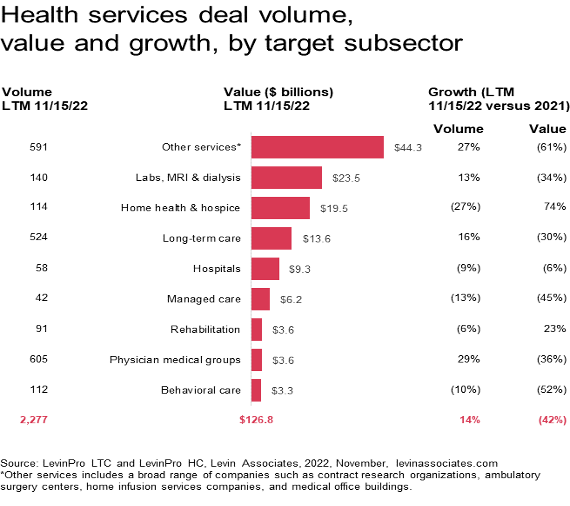Futurists and analysts are forever predicting various new-year opportunities for healthcare, from expansion and innovation to workforce priorities and strategic deselection and reduction. The twin juggernauts of economic impediments and recessionary fears, even with their challenges, will not slow down the need for healthcare. Healthcare leaders often struggle to navigate through this myriad of possibilities.

In 2021, there were 1,996 health services mergers and acquisitions valued at $217 billion, a high for the healthcare sector (Landi, 2022). In the last 12 months through Nov. 15, 2022, the health services sector has seen 2,277 deals valued at $127 billion, a deal volume jump of 14% from the previous year (PwC, 2022). Despite the economic downturn, the healthcare industry “has proven to be nearly recession-proof” (Landi, 2022).
At the same time as all these investment dollars are changing hands, many hospitals have struggled to stay afloat in recent years, adding layers of difficulty for hospital CEOs seeking to set the right priorities for their organization. A September 2022 report from the American Hospital Association discusses the variety of causes that led to 136 rural hospital closures from 2010 to 2021 and a record 19 closures in 2020 alone. Many longstanding pressures make the list, including low reimbursement, staffing shortages, low patient volume, and regulatory barriers, in addition to widespread challenges from the COVID-19 pandemic (American Hospital Association, 2022).
If billions of dollars are pouring into the healthcare sector, then why are many healthcare systems struggling and hospitals closing? Are there concrete steps hospital CEOs can take in 2023 to, at the least, insulate themselves, or perhaps even succeed amidst such challenges?
Don’t be paralyzed by “uncertainty”
Today, it is often lamented that we live in an “uncertain world” or that “everything is so unpredictable in these unprecedented times.” It may be hard to believe, but the world has been much more uncertain than it is now. The World Uncertainty Index (WUI) counts the percent of word the “uncertain” (or its variant) in the Economist Intelligence Unit country reports (World Uncertainty Index, 2022). According to their calculations, global uncertainty has decreased significantly from 2012 levels. It is important to remember that though we cannot be certain about everything, we have been in a more uncertain time. Hospitals and healthcare systems navigated their way through them, and they will again.
Mitigate the impact of inflation by focusing on employee retention
Whilst the world is uncertain about many things, we are certain that inflation will be a major challenge of 2023. A recent McKinsey and Company survey revealed that 46 percent of respondents said that “rising interest rates pose the biggest potential risk to organizational growth over the next 12 months” (Agrawal, Grube, & Podvoyskaya, 2022). In the past year, labor, supply, and capital cost increases have been rampant across healthcare, and there is no sign that this will ease in early 2023. In fact, some predict that these will most likely continue to the autumn of 2023 (McVey, 2022). Hospitals may want to adopt a short-term strategic plan to mitigate price increases, especially if navigating expansion and renovation plans, until costs come under control.
Instead, I recommend refocusing on supporting employee retention initiatives which will allow the hospital or system to be nimble when they decide to reengage in long-term plans or renovation programs (Mercer, 2022). According to a report by Mercer, “one out of every three employees report they’re considering leaving their employer, up from one in four last year” (Curry, 2022). Pay was cited as the top reason, as “employees who remain with their employers have noticed that colleagues who switch jobs often increase their pay more than those who remain in place” (Curry, 2022). If you want to retain quality staff, use this time waiting for inflation to cool to make moves to understand what your employees need in order to remain with your organization.

